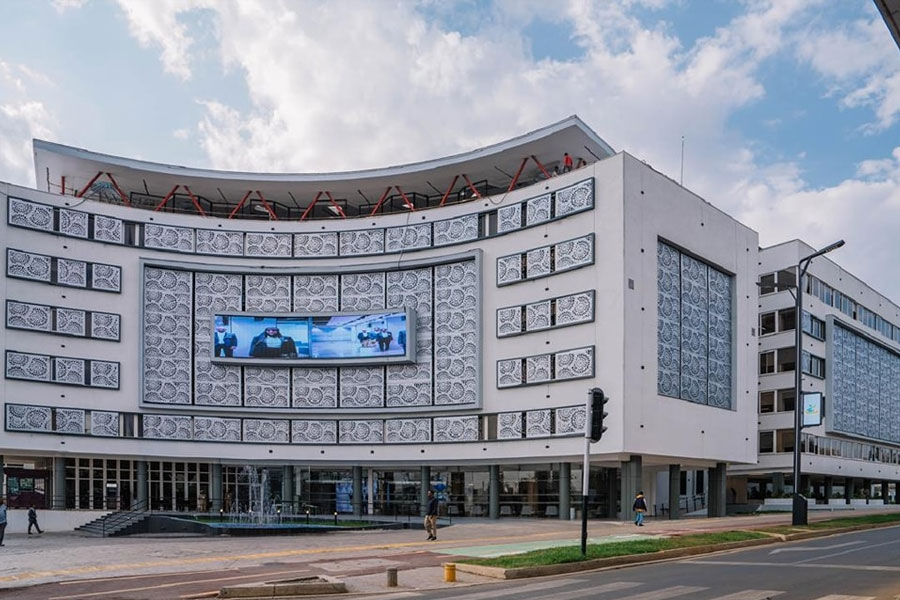
Fortune News | Aug 17,2025
In the finance world, where institutions' fluctuating fortunes often make headlines, Abay, a mid-sized financial institution, has found itself in the limelight for reasons that evoke optimism and caution. The Bank recently reported a marked increase in net profit, driven primarily by a significant surge in interest income. However, the uptick in performance has not translated into a proportionate rise in share earnings.
Considerable growth in interest income is at the heart of Abay's profit increase. Its ability to register a substantial increase in interest income is noteworthy. Yet, a closer examination reveals a less-than-rosy picture regarding share earnings. Despite the impressive growth in net profit, Abay's earnings per share (EPS) have not experienced a corresponding increase. The culprit behind this discrepancy is a fresh capital injection, which has, in effect, diluted the company's EPS.
Abay Bank netted 933.3 million Br, an increase of 10.2pc from last year. Although more than half of Berhan Bank's and three times that of Lion Bank, the mid-tier Bank's net profit was lower than other banks of its generation. Oromia Bank has made a 1.2 billion Br profit, and Zemen Bank 1.48 billion Br from the 2021/22 operation year.
However, the Bank's net profit margin of 35.8pc outperformed the industry average of 26.2pc, indicating a higher profit level for each Birr in revenue earned. Despite the high net profit margin contributing to its substantial return on investment (ROE), Abay Bank has not utilized its assets as efficiently as its peers. It has relied more on debt to finance its operations.
Abay Bank ranks second among its peer banks in total assets, with 40.7 billion Br, far ahead of Zemen and Berhan. Oromia Bank has the highest total assets at a little over 52 billion Br. However, Oromia Bank is ahead of Abay's 26.5 billion Br in loans and advances while Berhan Bank and Zemen Bank trail with 21 billion Br and 21.1 billion Br, respectively.
Yehuala Gessese, president of Abay Bank, attributed the high headline inflation and the negative socio-economic impact of the war in the north as critical phenomena affecting the domestic banking scene during the annual general assembly held in November 2022, held at the Inter Luxury Hotel.
Abay Bank's net profit was lower than other banks within its cohort. Oromia Bank and Zemen Bank reported profits of 1.2 billion Br and 1.48 billion Br, respectively, for the 2021/22 fiscal year. Its earnings per share (EPS) also experienced an 11.5pc decline from the previous year to 295 Br, which Yehuala attributed to a fresh capital injection of one billion Birr.
Abay Bank has a robust capital base, with a capital adequacy ratio (CAR) of 21pc. Its capital-to-branch ratio is double the industry average, giving it a competitive edge. With an aggregate capital of 210 billion Br and a branch network of over 6,500, Ethiopia's banking industry has a capital-to-branch ratio of 30.4pc.
The Bank was incorporated in 2010, with 125 million Br raised from 823 founding shareholders. More than 4,300 shareholders raised 3.97 billion Br last year, showing a 41.2pc increase from the previous year.
Mulatu Asfaw is one of the founding shareholders who concurred with the President's view that the northern war and global issues impacted the banking industry. He was not aware of the declined earnings per share.
Mulatu urged the management to prioritize investments for expansion.
Abay Bank's efficiency ratio, which measures expenses as a percentage of revenue, was 42.14pc, lower than the average for all banks. This efficient cost structure has contributed to its profitability.
Compared to its peers, the total expense of Abay, with 2.9 billion Br, is higher than Zemen by 800 million Br but remains lower than Oromia (4.3 billion Br) and Berhan (3.6 billion Br).
"This is concerning," said Abdulmenan Mohammed, a financial statement analyst at London Portobello Ltd.
The analyst suggested that the Bank's management should focus on cost control. He also recommended that the Bank pay attention to the downward trend in service charges and commissions, which declined by 3.5pc to 622.4 million Br. The gain in foreign exchange dealings fell by nine percent to 112.9 million Br.
The Bank President attributed the high expense to an expansion of branches accompanied by rental fees and human capital.
However, the Bank's rapid expansion has been met with concerns from branch managers. The internal staff turnover resulting from the expansion has led to new hires requiring training and customers receiving subpar service. One anonymous branch manager voiced concerns about the impact of these issues on branch performance.
"It's affected my branch's performance," the manager told Fortune.
The fiscal year also saw nearly 25pc of Abay Bank's branches rendered non-functional for almost six months due to the war in the north. Ethiopia Tadesse, chairwoman of the Board, noted that efforts were made to resume services as quickly as possible, albeit at a cost. Abay Bank's expenses, including provisions, increased significantly, undermining the performance achieved in increased interest income.
Abay Bank mobilised deposits of 32.4 billion Br, an increase of 35.6pc. The Bank's loan-to-deposit ratio slightly decreased by one percentage point to 82pc and was attributed as remarkable by the expert. The ratio is far below the pioneer Banks Abyssinia (91pc) and Awash (86pc). Abay Bank's equity multiplier (8.8), which is higher than the average for the industry's 7.7, showed Abay Bank used more debt relative to equity to finance its assets.
To improve its performance and compete with its peer banks, Abay Bank needs to focus on improving its asset quality and cost control, as well as exploring new sources of revenue generation, Abdulmenan said.
According to the expert, despite having a relatively lower exposure to international markets, Abay Bank could leverage its strong capital and liquid resources to generate more income.
The Bank's cash and bank balances, including treasury bills and time deposits, grew by 65pc from the previous year to 7.92 billion Br. The liquid assets to total assets ratio increased to 19.5pc, and the liquid assets to total liabilities ratio rose to 24.4pc.
The improvement in liquidity resulted primarily from the injection of more capital, mobilization of savings, and liquidation of financial assets. In addition, the provision for impairment of loans and other assets dropped by 13pc to 99.15 million Br, indicating that Abay had a sound credit management system.
PUBLISHED ON
Mar 18,2023 [ VOL
23 , NO
1194]

Fortune News | Aug 17,2025

Fortune News | Feb 11,2023

Addis Fortune | May 04,2024

Agenda | Apr 03,2021

View From Arada | May 24,2025

Delicate Number | Aug 03,2024

Radar | Mar 18,2023

Fortune News | May 17,2025

In-Picture | Sep 29,2024

Radar | Jun 26,2021

Dec 22 , 2024 . By TIZITA SHEWAFERAW
Charged with transforming colossal state-owned enterprises into modern and competitiv...

Aug 18 , 2024 . By AKSAH ITALO
Although predictable Yonas Zerihun's job in the ride-hailing service is not immune to...

Jul 28 , 2024 . By TIZITA SHEWAFERAW
Unhabitual, perhaps too many, Samuel Gebreyohannes, 38, used to occasionally enjoy a couple of beers at breakfast. However, he recently swit...

Jul 13 , 2024 . By AKSAH ITALO
Investors who rely on tractors, trucks, and field vehicles for commuting, transporting commodities, and f...

Oct 4 , 2025
Eyob Tekalegn (PhD) had been in the Governor's chair for only weeks when, on Septembe...

Sep 27 , 2025
Four years into an experiment with “shock therapy” in education, the national moo...

Sep 20 , 2025
Getachew Reda's return to the national stage was always going to stir attention. Once...

Sep 13 , 2025
At its launch in Nairobi two years ago, the Africa Climate Summit was billed as the f...